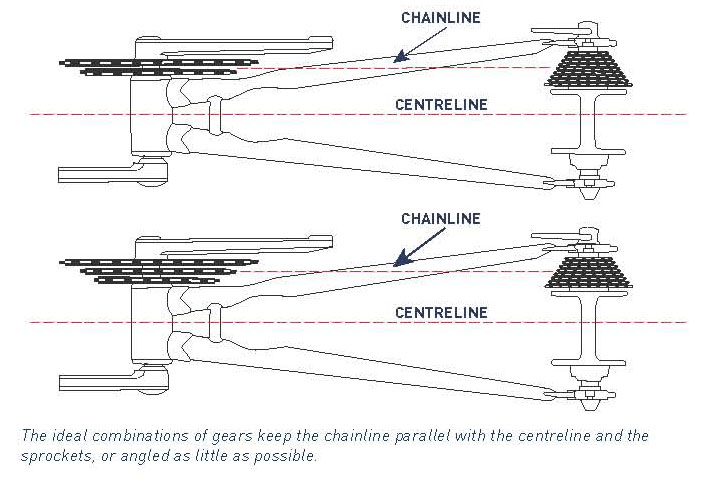Keep your chain as straight as possible and your derailleur gears will change more smoothly and need less maintenance. Simon Vincett offers a lesson in easier riding.
The bike chain works best when it is straight but it is its useful ability to run at an angle that makes derailleur gear systems possible. The art is to use combinations of gears that keep the chain straight, or angled as little as possible. Knowing the ideal combinations makes your bike run smoother and your chain and sprockets will last longer.
The chain is straight when it runs in the same plane as the sprockets that carry it (sprockets are the toothed wheels connected to the pedal arms – known as chainrings – and the rear wheel – known as cogs). Derailleurs shift the chain from one sprocket to another, both at the front, between chainrings, and at the back, between cogs.
While your bike might have a possible 18 or 24 gear combinations, some of the combinations may produce almost the same gear ratios. This means in effect you have more like 12 different speeds.
The table below shows the chainrings and cogs commonly found on a hybrid bike and commonly found on a road bike. The numbers refer to the number of teeth on the chainring or cog. Various combinations produce different gear ratios, which are expressed here as gain ratios. For instance, a gain ratio of 8.1 means that for every centimetre the pedal travels, the bike moves forward 8.1 centimetres. (For more on gain ratios see www.sheldonbrown.com/gain.)

To progress up the gears from lowest, for instance if you are riding up a steep hill, start in the smallest chainring (28) and the second largest cog (26). If you need a lower gear you can change down to the largest cog (28) for easier pedalling. As you crest the hill and the going gets easier, change to the 24 cog, then the 21 cog. The chain is on quite an angle now. To go faster from here, change to the middle chainring, then the 18 cog and the 16 cog. The chain angle has increased again, so it’s time to change up to the largest chainring. You’ll be in the 48 chainring and the 16 cog, which is your third highest gear. For top speed, change to the 14 cog and finally the 12 cog. You change down the gears in the reverse order.
You can see that having only two chainrings on a road bike front derailleur means more of a jump between gears when changing from one chainring to the other. However, switching between chainrings is more important for road bike gear systems because having more cogs and less chainrings means more angle used in more gears.
You can change the size of sprockets you have to fine tune your gears, with two major limitations. You may have to replace all the cogs at once because they often come as a set, and certain sizes of chainring only fit on certain cranksets (pedal arms). There are other compatibility issues, including the ‘capacity’ of the derailleurs you have. For a front derailleur this the largest and smallest chainrings it can shift to as well as the chain angle it can accommodate. For a rear derailleur there’s a limit on the largest cog it can accommodate. For more on derailleur capacity read the ‘Capacity’ entry in Sheldon Brown’s fabulous glossary.
Ride On content is editorially independent, but is supported financially by members of Bicycle Network. If you enjoy our articles and want to support the future publication of high-quality content, please consider helping out by becoming a member.

